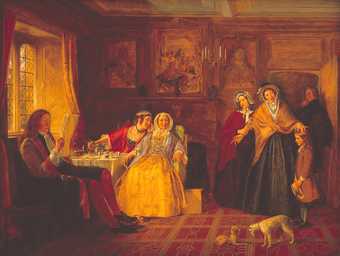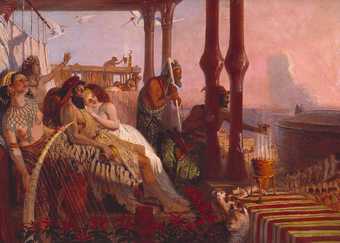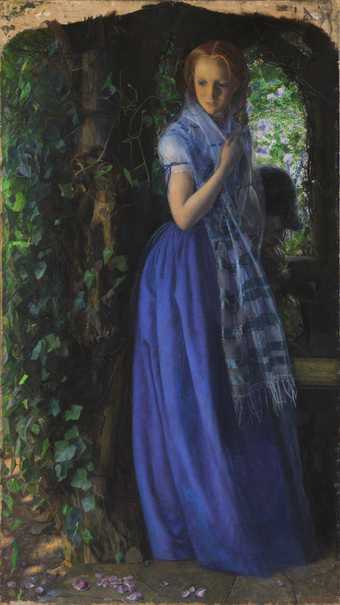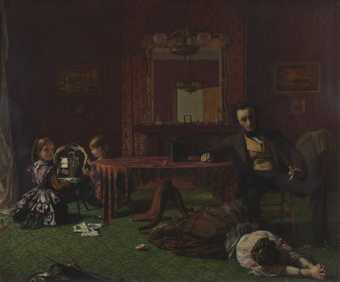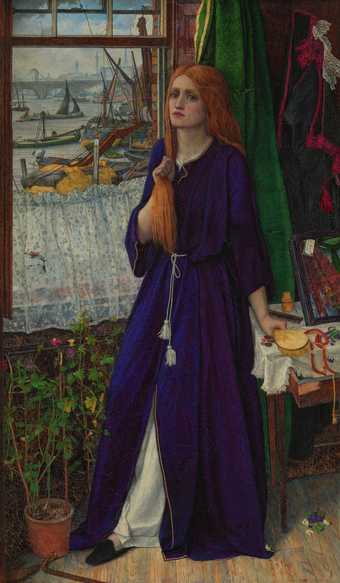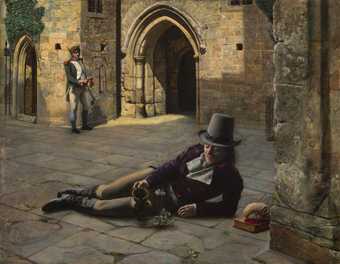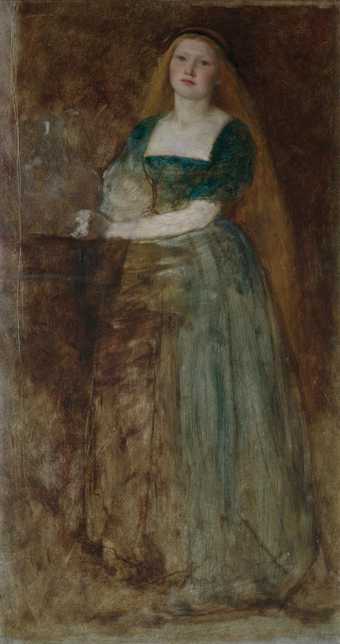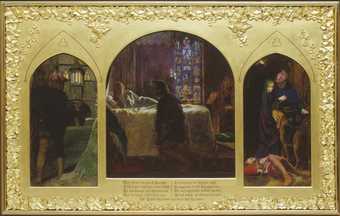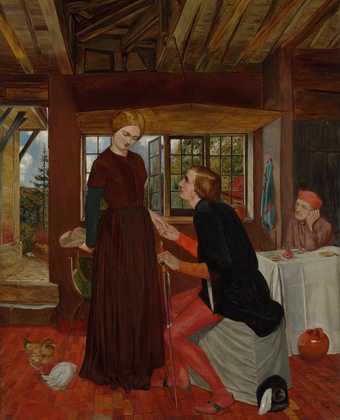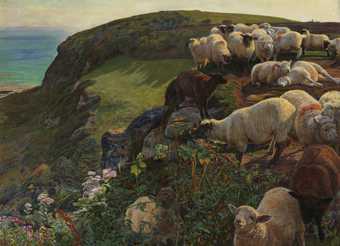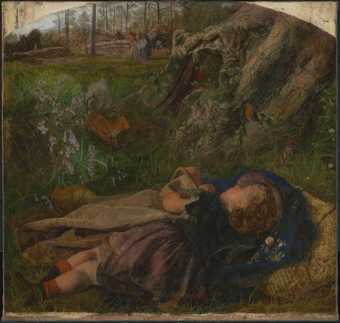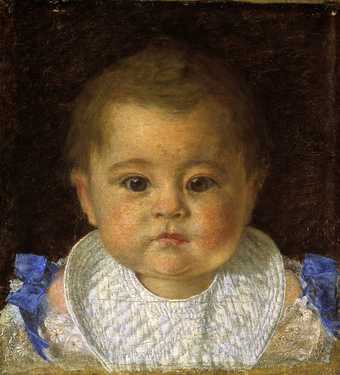
In Tate Britain
- Artist
- William Holman Hunt 1827–1910
- Medium
- Oil paint on canvas
- Dimensions
- Support: 762 × 559 mm
frame: 1060 × 857 × 97 mm - Collection
- Tate
- Acquisition
- Presented by Sir Colin and Lady Anderson through the Friends of the Tate Gallery 1976
- Reference
- T02075
Summary
The underlying spiritual message was generally ignored by most critics, who concentrated instead on the more sensational aspects of the composition. The model is Hunt's girlfriend Annie Miller, an uneducated barmaid whom he met in 1850 when she was fifteen.
Further reading:
Leslie Parris
(ed.), The Pre-Raphaelites, exhibition catalogue, Tate Gallery, London 1984, reprinted 1994, pp.120-21, reproduced in colour
Terry Riggs
March 1998
Does this text contain inaccurate information or language that you feel we should improve or change? We would like to hear from you.
Display caption
Hunt’s modern life painting represents a wealthy man visiting his mistress in an apartment which he has provided for her. The tune that he idly plays on the piano has reminded her of her earlier life and she rises from his lap towards the bright outside world (made visible to the viewer in the mirror). The claustrophobic space is filled with intricate clues, such as the bird trying to escape from a cat and the female figure enclosed in a glass dome, which echoes the shape of the painting.
Gallery label, November 2016
Does this text contain inaccurate information or language that you feel we should improve or change? We would like to hear from you.
Catalogue entry
T02075 THE AWAKENING CONSCIENCE 1853
Inscribed ‘Whh [in monogram] LON/1853’ b.l.
Oil on canvas, 30 × 22 (76.2 × 55.9)
Presented by Sir Colin and Lady Anderson through the Friends of the Tate Gallery 1976
Prov: Commissioned from the artist by Thomas Fairbairn 1853 and bought 1854 for 350 guineas; offered Christie's 7 May 1887 (141) bt. in £105; by descent to his son Sir Arthur Henderson Fairbairn; ... sold anonymously, Christie's 25 January 1946 (158) bt. Brown and Phillips £210; Colin Anderson by 1947.
Exh: RA 1854 (377); Exhibition of the Works of Modern Artists, Royal Manchester Institution 1854 (11); Birmingham Society of Artists 1856 (131); Art Treasures of the United Kingdom, Manchester 1857 (Modern Masters Section, 550); Liverpool Academy 1859 (72); ? 16 Hanover Street 1865; Pictures of Mr Holman Hunt, Fine Art Society 1886 (4); Glasgow International Exhibition, 1901 (Fine Art Section, 391); British Art Fifty years ago, Whitechapel Art Gallery 1905 (350); The Collected Works of W. Holman Hunt, City Art Gallery Manchester 1906 (17); Collected Exhibition of the Art of W. Holman Hunt, Walker Art Gallery, Liverpool 1907; (70); The Pre-Raphaelite Brotherhood, City Art Gallery, Birmingham 1947 (40); The Pre-Raphaelites, Whitechapel Art Gallery 1948 (38); Pre-Raphaelite Masterpieces, 1848–1862, City Art Gallery, Manchester 1948 (11); Paintings and Drawings by the Pre-Raphaelites and their followers, Russell-Cotes Art Gallery, Bournemouth 1951 (8); Masters of British Painting 1800–1950, Museum of Modern Art, New York 1956 (46); Victorian Paintings, Agnew's 1961 (53); Bicentenary Exhibition, RA 1968–9 (374); William Holman Hunt, Walker Art Gallery, Liverpool and Victoria and Albert Museum 1969 (27); La Peinture Romantique Anglaise et Les Préraphaélites, Petit Palais, Paris 1972 (144); The Pre-Raphaelites, Whitechapel Art Gallery 1972 (24).
Lit: Morning Chronicle, 29 April 1854; Athenaeum, 6 May 1854; The Times, 25 May 1854; Art Journal, 1854; pp.165–6; Athenaeum, 22 April 1865; W. Holman Hunt, ‘The Pre-Raphaelite Brotherhood: A Fight for Art. 111’, The Contemporary Review, XLIX, Jan–June 1886, pp.825, 829; W. M. Rossetti, Ruskin, Rossetti, Pre-Raphaelitism, 1889, pp.10–12; The Works of Ruskin, Library Edition, ed. E. T. Cook and Alexander Wedderburn, XII, 1904, pp.333–5 (Ruskin's 25 May 1854 letter to The Times); W. H. Hunt, Pre-Raphaelitism and the Pre-Raphaelite Brother-hood, 1905, 1, pp.347–8, 360, 405–6, 418–9, repr. facing p.448, 11, pp.428–33; ibid, 2nd ed. 1913, 1, pp.255, 259, 265, 267, 294–5, 300–4, 11, pp.2, 345–8, 403–5; Violet Hunt, The Wife of Rossetti: Her Life and Death, 1932, pp.49, 103; A. C. Gissing, William Holman Hunt, 1936, pp.84, 86 89, 97, 153, 208; William Gaunt, The Pre-Raphaelite Tragedy, 1942, pp.53–4; Robin Ironside and John Gere, Pre-Raphaelite Painters, 1948, pp.28, 31, repr. in colour p.29; Graham Reynolds, Painters of the Victorian Scene, 1953, p.74, repr. pl.42; The Arts, October 1956, p.32, repr.; T. S. R. Boase, English Art 1800–1870, 1959, pp.285–6, repr. pl.88a; Oswald Doughty, A Victorian Romantic: Dante Gabriel Rossetti, 1960, p.194; Graham Reynolds, Victorian Painting, 1966, pp.62, 95, 109; Anne d'Harnoncourt, The Awakening Conscience, unpublished M.A. thesis, Courtauld Institute of Art, 1967; Mary Lutyens, Millais and the Ruskins, 1967, p.222; Mary Bennett, William Holman Hunt, exhibition catalogue, 1969, pp.35–7, repr. pl.40; Diana Holman Hunt, My Grandfather, His Wives and Loves 1969, pp.104, 107, 113, 115, 124, 133–4, 203, 248; Mary Bennett, ‘Footnotes to the Holman Hunt Exhibition’, The Liverpool Bulletin, XIII, Walker Art Gallery, 1968–70; Timothy Hilton, The Pre-Raphaelites, 1970, pp.92–3, repr.fig.56; G. H. Fleming, That Ne'er Shall Meet Again, 1971, p.2; Linda Nochlin, Realism, 1971, pp.201, 268, repr. fig.130; Ruari McLean, Victorian Book Design and Colour Printing, 2nd ed. 1972, p.210; A. I. Grieve, The Art of Dante Gabriel Rossetti. 2: The Pre-Raphaelite Modern-Life Subject, Norwich, 1976, pp.34–6; ‘The Awakening Conscience and the Still Small Voice’, 1976–8, T.G. Illustrated Biennial Report, 1978, pp.21–9.
Hunt conceived the idea for the painting while he was working on ‘The Light of the World’ (Keble College, Oxford) between 1851 and 1853. In the first edition of his memoirs, Hunt stated that he thought of ‘The Awakening Conscience’ in 1851, but in the second edition revised this date to 1853. The picture was certainly begun by February 1853, according to a letter from Millais to Thomas Combe (quoted by J. G. Millais, The Life and Letters of Sir John Everett Millais, 3rd ed. 1902, 1, p.191), and completed in January 1854, when Hunt departed for the Middle East. Hunt had shown his design to Augustus Egg, who seems to have obtained for him a commission for the painting from the Manchester businessman Thomas Fairbairn. It was intended as a ‘material counterpart’ to the ‘spiritual subject’ of ‘The Light of the World’, to represent ‘the manner in which the appeal of the spirit of heavenly love calls a soul to abandon a lower life’ (Hunt, 1913, II, p.346). Both paintings were exhibited at the Royal Academy in 1854.
Letters of 1854 between Hunt, Egg and Combe (now in a private collection and the Bodleian Library, Oxford) show that Hunt's original title for the picture was ‘The still small voice’ and that it was Combe who suggested ‘The Awakening Conscience’. The painting caused controversy when it was exhibited, mainly because of the subject-matter, which was in any case misunderstood. Ruskin wrote a letter to The Times on 25 May 1854 explaining the subject and the symbolism of some of the details. Hunt's subject is that of a young gentleman visiting his mistress in the house or apartment in which he has installed her. As they play and sing a setting of Thomas Moore's Oft in the Stilly Night, the woman's conscience is awakened to memories of her childish innocence and she rises from her lover's lap, gazing past the spectator through the window to the sunlit garden we see reflected in the looking-glass behind her. The room, brightly lit and colourfully decorated, is full of details symbolic of her predicament: a cat has caught a bird under the table; the wallpaper depicts a cupid sleeping while birds eat the grapes and corn; the clock on the piano is encased in a glass dome; the music sheet of Edgar Lear's setting of Tennyson's Tears, idle tears lies on the floor, as does the man's glove and the tangled wools of an unfinished tapestry; on the table are books one of which has been identified by Ruari McLean as Henry Noel Humphrey's The Origin and Progress of the Art of Writing; on the wall is a print of a girl in an attitude of penitence (identified by Ruskin as the woman taken in adultery, by Fleming as Jane Shore, but most probably a penitent Magdalen); the flowers on the piano may be carnations and anemones (symbols of betrothal and rejected love). The frame bears a star above the head of the woman, and a frieze of alternating bells and marigolds, symbols of warning and sorrow.
In his memoirs, Hunt stated that his inspiration was old Peggotty's search for Emily in Dickens's David Copperfield (1850); Grieve has pointed out the relevance of Wilkie Collins's novel Basil (1852), and the description in chapter ten of the interior of a linen-draper's house is very close to that of Hunt's picture. Bulwer Lytton's Ernest Maltravers (1837) may also have inspired Hunt; the Athenaeum critic said of the painting that ‘the sentiment is of the Ernest Maltravers school’.
The model for the woman was Hunt's mistress Annie Miller, and for the man, either Thomas Seddon (whose contemporary photograph, repr. Hunt, 1913, I, p.265, the painting closely resembles) or Augustus Egg. The man's face bears the strongest resemblance to that of the central figure of Rossetti's ‘Mary Magdalene at the Door of Simon the Pharisee’ (1853–9; Fitzwilliam Museum, Cambridge). The only known drawing connected with the picture is a slight sketch published by Mary Bennett (private collection; Bennett 1968–70, repr. facing p.27). This may be the ‘scribbles’ that Hunt showed Egg in 1853. Mary Bennett notes that the ‘basic concept of the woman springing up from her lover's lap by a piano together with the important motif of the window viewed through the mirror in the background, were planned from the first’.
In 1856 and 1857 Hunt worked again on the painting, apparently repainting the woman's face at the wish of the owner Fairbairn, because her original expression was too pained. In a letter to Edward Lear of 16 April 1857 (John Rylands Library, Manchester) Hunt wrote: ‘...lately I have had the Awakening Conscience on my easel for a month - in the Spring I had worked on the head of the girl before sending it to Birmingham [Society of Artists exhibition in 1856] - when I was suffering from fever - which defeated my attempt to improve it. I think that I have materially bettered it now - it is now at Manchester - in the Art Treasures [Exhibition] -’. It is hoped that photography in ultra-violet and infra-red light, and x-rays, undertaken by the Conservation Department, will reveal the more exact nature of Hunt's repainting. According to Gissing (p.90, n.1), with no supporting evidence, Hunt regretted that he had changed the girl's facial expression.
Inscriptions in the spandrels, usually covered by the frame, show that Hunt retouched the painting in 1864 and 1886. Hunt wrote, in the left spandrel: ‘Painted with Copal (oil) weak originally, diluted in use with R. [? for ‘rectified’] S[pirit] of Turps/for drawing out parts/E[merald] Green & Gamboge in transparent/part of foliage. picture retouched/with same Vehicle in 1864/W Holman Hunt/Please copy the above/Note before/obliterating it’. In the right spandrel: ‘THE PICTURE WAS VARNISHED WITH [‘CRACKED’ INSERTED ABOVE]/MASTIC IN 64 ON ALL PARTS BUT THE/GIRL. AFTER A FEW YEARS ALL THE/VARNISHED PARTS WERE CRACKED THE/REST NOT AT ALL. A RESTORER/FILLED UP THE CRACKS/WITH COLOR AND MASTIC/THIS HAS NOW BEEN/TAKEN OFF AND/I HAVE NOW/FILLED UP WITH/AMBER/86’. In both spandrels there is some illegibly faint pencil writing.
Judith Bronkhurst has drawn attention to two letters (Bodleian Library, Oxford) of 1879 from Hunt to F. G. Stephens which indicate that at that time also Hunt was concerned with repainting: he wrote of this picture and of ‘Claudio and Isabella’ (Tate N03447) being ‘out of order thro premature varnishing with Mastic I do both without charge but the continual writing about these would make one suppose I was being [granted] the greatest favor in being allowed to put these in order’. The second letter shows he was dealing with Lady Fairbairn: ‘I had had some rather severe fencing with the family because Lady F ... took it into her-no-tail to bother me to leave off all my chance with my picture [The Triumph of the Innocents] ... to complete the retouching of the A.C....’
Information kindly supplied by Judith Bronkhurst, Mrs Léon Quartermaine and Geoffrey Squire.
Published in:
The Tate Gallery 1976-8: Illustrated Catalogue of Acquisitions, London 1979
Film and audio
Features
Explore
- architecture(30,960)
- garden structures(1,939)
-
- garden(1,191)
- emotions and human qualities(5,345)
-
- complacency(14)
- contemplation(141)
- guilt(35)
- domestic(1,795)
-
- living room(292)
- music and entertainment(2,331)
-
- music(916)
- clothing and personal items(5,879)
- embroidery(12)
- instrument, piano(138)
- clock(88)
- actions: expressive(2,622)
- hands clasped(166)
- UK countries and regions(24,355)
-
- England(19,202)
- Bible: Old Testament(381)
-
- Proverbs(1)
- sin(11)
- sex and relationships(833)
-
- affair(964)
- flirtation(45)
- morality(57)
You might like
-
Richard Redgrave Country Cousins
?1847–8, exhibited 1848 -
William Bell Scott The Eve of the Deluge
1865 -
Robert Braithwaite Martineau The Last Day in the Old Home
1862 -
Arthur Hughes April Love
1855–6 -
Augustus Leopold Egg Past and Present, No. 1
1858 -
John Roddam Spencer Stanhope Thoughts of the Past
exhibited 1859 -
Robert Braithwaite Martineau Picciola
1853 -
Joanna Mary Wells Gretchen
1861 -
Dante Gabriel Rossetti St Catherine
1857 -
Arthur Hughes The Eve of St Agnes
1856 -
Frederic George Stephens The Proposal (The Marquis and Griselda)
c.1850 -
William Morris La Belle Iseult
1858 -
William Holman Hunt Our English Coasts, 1852 (‘Strayed Sheep’)
1852 -
Arthur Hughes The Woodman’s Child
1860 -
Joanna Mary Wells Portrait of Sidney Wells
1859

